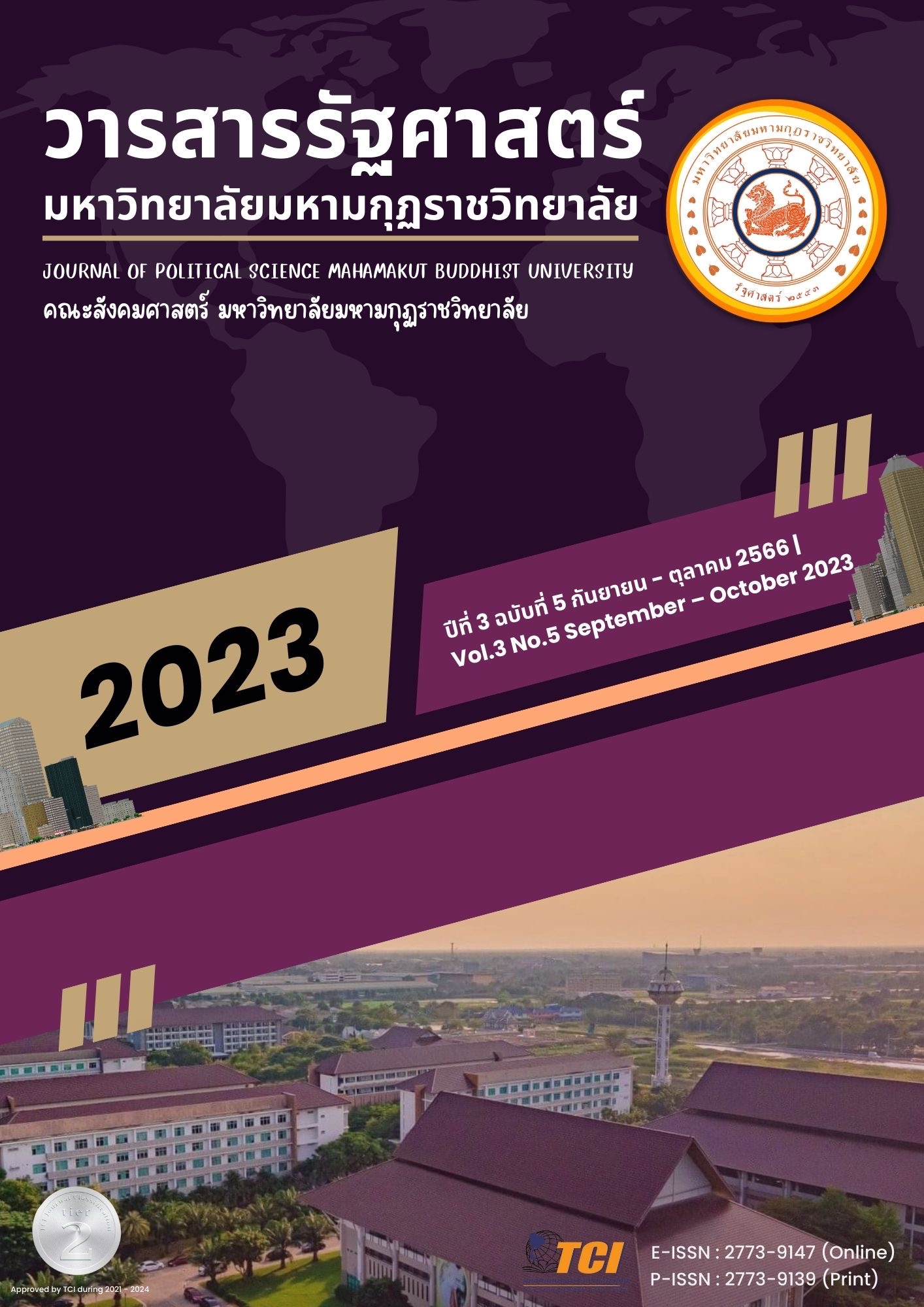INNOVATION IN SOLAR ENERGY BUSINESS MANAGEMENT FOR MANUFACTURERS IN THE LOWER CENTRAL REGION 2
Main Article Content
Abstract
The purpose of research on Solar Energy Business Management Innovation of Producers in the Lower Central Region 2 were to study (1) innovation in solar power business management of manufacturers in the lower central region 2 that affects the growth of the power generation business, (2) conditions of problems and obstacles affecting the development of solar power in the lower central provinces 2 and (3) development model for solar energy business management innovation of producers in the lower central region 2. It was a qualitative research, which collected data from in-depth interviews with 20 people involved in solar energy business management of manufacturers in the lower central region 2, by selecting a specific model from Phetchaburi Province and Prachuap Khiri Khan Province which is an area with many entrepreneurs and content analysis.
The research results found that ; (1) Innovations in solar power business management for producers in the lower central region 2, that affect the growth of the power generation business, consisting of process, data and information, development of high-voltage transmission line networks, Increasing energy consumption targets, Increasing solar power production and business plans, (2) conditions of problems and obstacles affecting the development of solar power in the lower central region 2 consisting of the input factors, including costs, legal issues, administrative procedures and obtaining permits according to the requirements, organizational structure limitations of the transmission system, research and development, production process for distribution of products and the impact on the area, and (3) The innovation development model for solar energy business management of producers in the lower central region 2 according to NISA Model, consists of networking, innovation development, strategic plan organization, administration in the form of 5p (plan, products, power of participatory, public Relations, promotion)
Article Details

This work is licensed under a Creative Commons Attribution-NonCommercial-NoDerivatives 4.0 International License.
References
กรมพัฒนาพลังงานทดแทนและอนุรักษ์พลังงาน กระทรวงพลังงาน. (2564). โครงการพัฒนาฐานข้อมูลความเข้มรังสีดวงอาทิตย์และระบบเชื่อมโยงฐานข้อมูลความเข้มรังสีดวงอาทิตย์ของประเทศไทย. สืบค้นเมื่อ 5 กันยายน 2566. จาก https://webkc.dede.go.th/testmax/node/5993.
กาญจนา ทองรอด, เทคโนโลยีคอมพิวเตอร์. (2566). สัมภาษณ์. 17 กุมภาพันธ์.
ชาณิกา ปัญจพุทธานนท์และรัตพงษ์ สอนสุภาพ. (2559). ปัญหาและอุปสรรคของการพัฒนาพลังงานไฟฟ้าจากแสงอาทิตย์ในประเทศไทย. วารสารวิจัยและพัฒนาวไลยอลงกรณ์ในพระบรมราชูปถัมภ์ สาขามนุษยศาสตร์และสังคมศาสตร์, 12 (11),11-12.
ธีรภัทร ดำรงธรรม, ผู้ดูแลโครงการ. (2566). สัมภาษณ์. 16 กุมภาพันธ์.
ธีรภัทร ดำรงธรรม, ผู้ดูแลโครงการ. (2566). สัมภาษณ์. 17 กุมภาพันธ์.
ธีรภัทร ดำรงธรรม, ผู้ดูแลโครงการ. (2566). สัมภาษณ์. 18 กุมภาพันธ์.
ณัฐพงศ์ สุขวิชา, ช่างเทคนิค. (2566). สัมภาษณ์ 16 กุมภาพันธ์.
ณัฏรี ศรีดารานนท์ โสภา วิศิษฏ์ศักดิ์ และ โจเซฟ เคดารี. (2561). แนวคิดในการพัฒนานวัตกรรมการใช้พลังงานแสงอาทิตย์สำหรับอาคารในเขตร้อนชื้น. วารสารสิ่งแวดล้อมสรรค์สร้างวินิจฉัย คณะสถาปัตยกรรมศาสตร์ มหาวิทยาลัยขอนแก่น, 17 (2), 12-13.
ณิชาภัทร วิสุทธิปราณี. (2560). แนวทางการจัดการระบบผลิตไฟฟ้าพลังงานแสงอาทิตย์ตามปรัชญาของเศรษฐกิจพอเพียงในชุมชน จังหวัดสิงห์บุรี. ใน วิทยานิพนธ์หลักสูตรวิทยาศาสตรมหาบัณฑิต (การจัดการสิ่งแวดล้อม) คณะบริหารการพัฒนาสิ่งแวดล้อม. สถาบันบัณฑิตพัฒนบริหารศาสตร์.
ทศพล มัคสิงห์, ผู้จัดการฝ่ายโครงการและงานวิศวกรรม. (2566). สัมภาษณ์. 15 มีนาคม.
นิวัฒน์ พานพนัส, ช่างเทคนิค. (2566). สัมภาษณ์. 17 กุมภาพันธ์
ประสงค์ มากชลบท, ช่างเทคนิค. (2566). สัมภาษณ์. 16 กุมภาพันธ์.
ผู้จัดการโรงงาน. (2566). สัมภาษณ์. 28 กุมภาพันธ์.
ผู้จัดการโรงงาน/ฝ่ายควบคุมการผลิต. (2566). สัมภาษณ์, 15 มินาคม.
ฝ่ายควบคุมการผลิต. (2566). สัมภาษณ์. 28 กุมภาพันธ์.
พรพจน์ ศรีดัน. (2562). พลังงานทดแทนกับแนวทางในการพัฒนาด้านพลังงานอย่างยั่งยืน. กลุ่มวิจัยชุมชนและสิ่งแวดล้อม สถาบันวิจัยสังคม. จุฬาลงกรณ์มหาวิทยาลัย.
มหาวิทยาลัยเทคโนโลยีพระจอมเกล้าธนบุรี. (2561). การติดตามสถานภาพการผลิตไฟฟ้าจากพลังงานแสงอาทิตย์ของประเทศไทย. กรุงเทพมหานคร: กรมพัฒนาพลังงานทดแทนและอนุรักษ์พลังงาน กระทรวงพลังงาน.
ยุทธพล มัคสิงห์, ผู้จัดการฝ่ายโครงการและงานวิศวกรรม. (2566). สัมภาษณ์, 17 กุมภาพันธ์.
วิจัยกรุงศรี. (2564). แนวโน้มธุรกิจ/อุตสาหกรรม ปี 2564-2566: ธุรกิจผลิตไฟฟ้า. เรียกใช้เมื่อ 10กันยายน 2564. จาก https://www.krungsri.com/th/research/industry/industry-outlook/Energy-Utilities/Power-Generation/IO/io-power-generation-21.
ศิวนันท์ ศิวะพิทักษ์. (2554). การจัดการนวัตกรรมขององค์กรธุรกิจที่มีผลต่อการสร้างสรรค์นวัตกรรมของพนักงาน. ใน ดุษฎีนิพนธ์หลักสูตรบริหารธุรกิจดุษฎีบัณฑิต. มหาวิทยาลัยธุรกิจบัณฑิตย์.
ศุภฤกษ์ กังวาลรัตน์, กรรมการบริษัทหนุมาน เทคโนโลยี แอนด์ ลีเกิล จำกัด. (2566). สัมภาษณ์. 15 มีนาคม.
สมนึก เอื้อจิระพงษ์พันธ์ และคณะ (2553). นวัตกรรม : ความหมาย ประเภท และความสำคัญต่อการเป็นผู้ประกอบการ. วารสารบริหารธุรกิจ, 33(128), 50-55.
สรรพร อุไรกุล. (2560). นวัตกรรมยุคใหม่ ขับเคลื่อนได้ด้วยพลังงานหมุนเวียน. เรียกใช้เมื่อ 12 กันยายน 2564. จาก https://www.greenpeace.org/thailand/story/2779/ innovation renewable-energy/.
สุริยาวุธ กิตติภูวดล, ขวัญมิ่ง คำประเสริฐ, อนันตกุล อินทรผดุง และ พัฒนพงษ์จันทร์ควง. (2565). ยุทธศาสตร์การพัฒนารูปแบบการจัดการผลิตไฟฟ้าด้วยพลังงานแสงอาทิตย์ บนหลังคาโดยผู้ประกอบการและผู้ใช้ภาคครัวเรือน พื้นที่เขตคันนายาว กรุงเทพมหานคร. Journal of Modern Learning Development, 7(2), 301.
BCPG Public Company Limited. (2018). พลังงานแสงอาทิตย์. เรียกใช้เมื่อ 12 กันยายน 2564. จาก https://www.bcpggroup.com/th/our-business/solar-Power.
Greenpeace Thailand. (2017). นวัตกรรมยุคใหม่ ขับเคลื่อนได้ด้วยพลังงานหมุนเวียน. เรียกใช้เมื่อ 12 กันยายน 2564. จาก ttps://www.greenpeace.org/thailand/ story/2779innovation-renewable-energy/
Gropal Lal Modi, Direct Manager. (2566). สัมภาษณ์. 9 มีนาคม.


